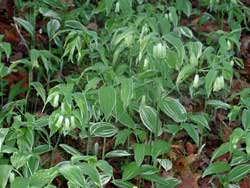Resource Library
Plant of the Week: Japanese Fairy Bells
The University of Arkansas System Division of Agriculture does not promote, support or recommend plants featured in "Plant of the Week." Please consult your local Extension office for plants suitable for your region.
Plant of the Week
[A-Z]
Japanese Fairy Bells
Latin: Disporum sessile Variegatum

In the garden, there is always a kind of tension between aggression and wimpdom. We want our plants to play nicely together but not be so aggressive they try to take over. I’ve decided one of my choice woodland plants, Japanese fairy bell (Disporum sessile ‘Variegatum,’ has crossed that line. It’s got to go.
Disporum is a genus of woodland plants belonging to the Lily family, at least if you take the conservative view. It is an East Asian genus of about 25 species that has five closely related – but now reclassified to the genus Prosartes – species in North America. Three of these are found in the Pacific Northwest and two in the Appalachian Mountains. Disporum shares close relationship with other common woodland plants such as Solomon seal (Polygonatum) and Merry bells (Uvularia).
The variegated Japanese fairy bells grow about 18 to 24 inches tall with slender, erect growing herbaceous stems bearing alternating, 4-inch long glabrous, white-striped leaves. It spreads rapidly by underground stolons and can form large colonies in a few years.
Plants emerge in early spring and flower within a few weeks. The inch-long white, but green-tinged, flowers are produced in pairs near the top of the plant. A pair of blue-black, pea-sized berries is produced at the ends of inch-long peduncles. The genus name means two seeds and is a reference to the pair of berries found on most species.
Disporum sessile is native to Japan and adjacent areas of China and Korea. It varies considerably in form throughout its range. Bailey in 1914 mentions the Asian species are little known in American gardens but by mid century the variegated form begins to appear in references. A number of fancy-leafed variegated forms are grown in Japan. In recent years, many of these have been introduced to American gardens.
The variegated form of Japanese fairy bells is a pretty plant that grows without fuss in any partially shaded woodland soil. It’s hardy from zone 4 through 9. It grows best in slightly acidic, organic matter rich soils well supplied with moisture during the growing season. If given reasonable moisture during the summer, the foliage will persist until killed by frost. It’s unaffected by insect or disease problems.
Several noted nurserymen defend this plant, describing it as a strong grower without thuggish ways. For me, it has been thuggish, overrunning the trilliums, primula and columbines that share its bed. If planted in a large woodland garden where its competitors were tall-growing plants, perhaps it would be more restrained. If the colorful, white-striped leaves are desired in an area where it cannot be allowed to run freely, its roots could be contained by planting it in a bottomless nursery container buried up to the rim.
By: Gerald Klingaman, retired
Extension Horticulturist - Ornamentals
Extension News - September 5, 2008
The University of Arkansas System Division of Agriculture does not maintain lists of retail outlets where these plants can be purchased. Please check your local nursery or other retail outlets to ask about the availability of these plants for your growing area.